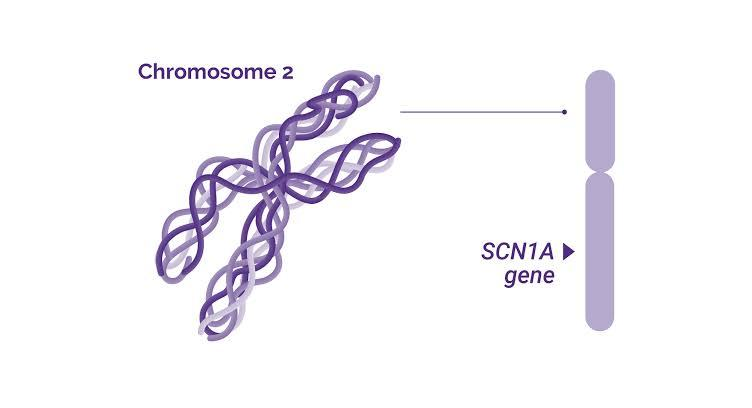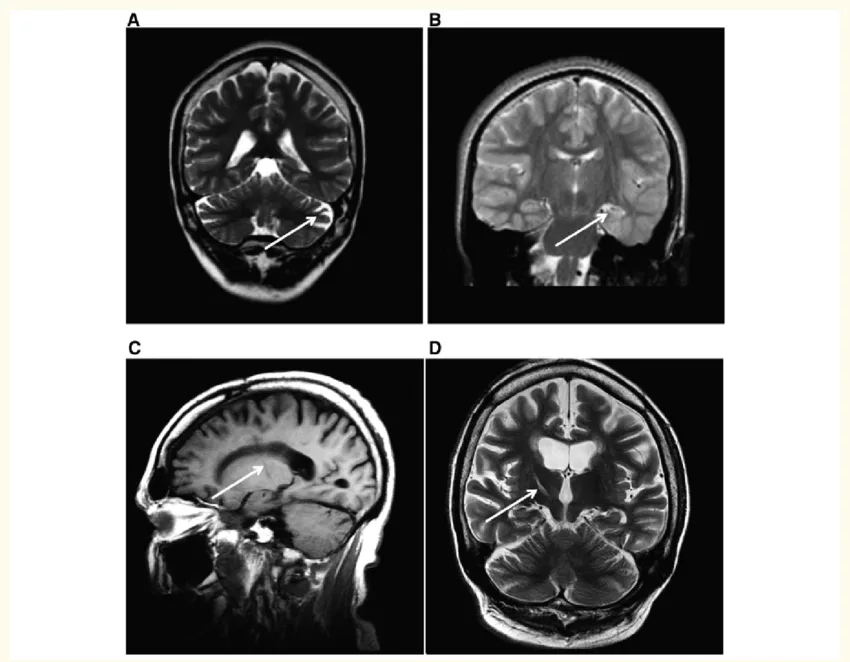Dravet syndrome is a rare and catastrophic form of epilepsy that begins in infancy or early childhood. It is characterized by prolonged and recurrent seizures that are often triggered by fever but later occur without any identifiable cause. Over time, affected children develop cognitive, motor, and behavioral impairments, leading to significant developmental delays. The condition is primarily caused by mutations in the SCN1A gene, which affect sodium channel function in the brain.
What is Dravet Syndrome?
Dravet syndrome is a rare and one of the most severe forms of epilepsy. Seizures typically begin within the first year of life, often associated with fever (febrile seizures).1Anwar A, Saleem S, Patel UK, Arumaithurai K, Malik P. Dravet Syndrome: An Overview. Cureus. 2019 Jun 26;11(6):e5006. doi: 10.7759/cureus.5006. PMID: 31497436; PMCID: PMC6713249. Initially, these seizures may appear unilateral, affecting either the left or right side of the body, but they later evolve into multiple seizure types, including:
- Tonic-clonic seizures – Stiffening and jerking of the body
- Myoclonic seizures – Brief muscle jerks
- Focal seizures – Seizures affecting a specific part of the brain
- Status epilepticus – Prolonged, life-threatening seizures that require emergency intervention
It was previously known as severe myoclonic epilepsy of infancy (SMEI). It’s an autosomal dominant disorder where inheriting the mutated gene (SCN1A) from one parent can lead to its manifestation. However, roughly 90% of SCN1A mutations occur de novo (newly mutated on its own), are exclusively present in the child, and are not inherited. The remaining 4% to 10% are inherited from a parent.2Dravet syndrome. (n.d.). Cleveland Clinic. Retrieved September 14, 2023, from https://my.clevelandclinic.org/health/diseases/22517-dravet-syndrome
What Causes Dravet Syndrome?
The primary cause of Dravet syndrome is a mutation in the SCN1A gene, which is responsible for encoding a sodium channel (Nav1.1) that regulates electrical activity in neurons. Mutations in this gene disrupt sodium ion flow in and out of nerve cells, leading to overexcitation of brain signaling, which causes seizures.3Gao C, Pielas M, Jiao F, Mei D, Wang X, Kotulska K, Jozwiak S. Epilepsy in Dravet Syndrome-Current and Future Therapeutic Opportunities. J Clin Med. 2023 Mar

While most cases of Dravet syndrome occur by De Novo mutations, some children with a family history of epilepsy or febrile seizures may develop Dravet syndrome, sometimes as part of a broader condition called GEFS+(Genetic Epilepsy with Febrile Seizures Plus), which affects multiple family members with varying severity.
Prevalence of Dravet Syndrome
This syndrome has a birth prevalence of 1 in 30,000 (range 1 in 15,000 to 40,000).4W. Owen Pickrell, Florent Guelfucci, Monique Martin, Rowena Holland, Richard F.M. Chin, Prevalence and healthcare resource utilization of patients with this syndrome: Retrospective linkage cohort study Seizure: European Journal of Epilepsy, Volume 99,2022, Pages 159-163, ISSN 1059-1311 It is present in 3% to 8% of children who have their first seizure before the age of 12 months.
Symptoms of Dravet Syndrome
Symptoms vary from child to child. Some seizure-related symptoms include:
- Seizures typically start in the first year of life, often as prolonged hemiclonic (affecting one side of the body) or generalized clonic seizures.5Connolly, M. (2016). Dravet Syndrome: Diagnosis and Long-Term Course. Canadian Journal of Neurological Sciences, 43(S3), S3-S8. doi:10.1017/cjn.2016.243
- Febrile seizures are common and may be triggered by fever or warm baths.
- Other seizure types develop between ages one and four, including myoclonic (brief muscle jerks), atypical absence seizures (staring spells with brief loss of awareness), focal (affecting one part of the brain), and generalized tonic-clonic seizures (widespread convulsions with muscle stiffening and jerking).
- Seizures often last longer than 15 minutes, particularly during febrile episodes.
- Status epilepticus (prolonged seizures lasting over five minutes) is common and can be life-threatening.
Other Symptoms Beyond Seizures
Some other symptoms include:
- Face difficulties in behavior, intellect, and development
- Growth and nutrition issues
- Many children exhibit autistic traits, hyperactivity (ADHD), aggression, and impulsivity.
- Sleeping difficulty and anxiety
- Dysautonomia– Dysfunction of the autonomic nervous system, leading to irregular heart rate, blood pressure instability, and temperature regulation issues.6Dravet syndrome. (n.d.). Cleveland Clinic. Retrieved September 14, 2023, from https://my.clevelandclinic.org/health/diseases/22517-dravet-syndrome
- Confusion or memory loss
- Aggression and impulsivity
- Imprecise speech
- Ataxia (Poor Coordination)
- Hypotonia (Decreased Muscle Tone)
- Many children develop a crouch gait, characterized by bent knees and difficulty walking.
- In the later stages, individuals may develop antecollis (forward neck flexion) and parkinsonism-like symptoms, including bradykinesia, rigidity, postural instability, and gait abnormalities, due to progressive neurological impairment.7Fasano A, Borlot F, Lang AE, Andrade DM. Antecollis and levodopa-responsive parkinsonism are late features of Dravet syndrome. Neurology. 2014 Jun 17;82(24):2250-1. doi: 10.1212/WNL.0000000000000521. Epub 2014 May 21. PMID: 24850485; PMCID: PMC4113465.
How to diagnose Dravet Syndrome?
Early diagnosis can protect patients from long-term complications
Electroencephalogram (EEG):
EEG appears to be normal in the first year of life. However, after two years of age, it shows generalized and multifocal epileptic form type of activity.
MRI:
Concerning MRI, it appears to be normal in most of the cases and in early years but in some cases MRI shows abnormalities that are cerebral atrophy and hippocampus sclerosis.
Importantly, not all patients with hippocampus sclerosis have this syndrome.8Connolly, M. B. (2016). Dravet syndrome: Diagnosis and long-term course. The Canadian Journal of Neurological Sciences. Le Journal Canadien Des Sciences Neurologiques, 43(S3), S3–S8. https://doi.org/10.1017/cjn.2016.243

Gene Test:
A genetic test for SCN1A mutations is performed when clinical symptoms suggest Dravet syndrome. Approximately 90% of patients have an SCN1A mutation, confirming the diagnosis. If SCN1A testing is negative, other epilepsy-related genes may be examined.
How to treat Dravet Syndrome?
Controlling and stopping seizures as early and effectively as possible may improve a child’s cognition, reduce the risk of sudden unexpected death in epilepsy (SUDEP), and improve the overall child’s long-term condition.
Medical Treatment
- First-line treatments: Sodium valproate and clobazam are often the first-line medications for controlling seizures in DS patients.
- Second-line treatment options: Second-line options like Topiramate and Stiripentol (Diacomit – Approved specifically for Dravet syndrome in combination with valproate and clobazam) are used if first-line treatment is ineffective.9Frampton JE. Stiripentol: A Review in Dravet Syndrome. Drugs. 2019 Nov;79(16):1785-1796. doi: 10.1007/s40265-019-01204-y. PMID: 31617141.
- Cannabidiol (CBD) Therapy: A purified form of CBD (Epidiolex) reduces the frequency of seizures by less than equal to 50%.10Koubeissi M. Anticonvulsant Effects of Cannabidiol in Dravet Syndrome. Epilepsy Curr. 2017 Sep-Oct;17(5):281-282. doi: 10.5698/1535-7597.17.5.281. PMID: 29225539; PMCID: PMC5716495.
Surgical & Device-Based Therapies
- Vagus nerve stimulation (VNS) – A small device implanted in the chest sends electrical impulses to the brain to reduce seizure frequency.
- Deep brain stimulation (DBS) – Used in rare cases when seizures remain uncontrolled.
Supportive Treatment
- Family counseling and support: These are crucial in the treatment plan, including fever and seizure management and rescue medication administration.
- Exercise: in order to improve muscle strength, balance, and coordination.
- Ketogenic diet: A good alternative to seizure management medications. It reduces the frequency of seizures along with behavioral issues, hyperactivity, ADHD, and aggressiveness.
Medicines that should be avoided: Dilantin (phenytoin), Tegretol (carbamazepine), Banzel (rufinamide), Lamictal (lamotrigine), Cerebyx (fosphenytoin), and Trileptal (oxcarbazepine), these are sodium channel blockers that are contraindicated for this syndrome as they lead to disease progression.11Neidler, S. (2018, July 11). Sodium channel blockers in Dravet syndrome. Dravet Syndrome News. https://dravetsyndromenews.com/sodium-channel-blockers-in-dravet-syndrome/
Can Dravet Syndrome be cured?
Dravet syndrome is a lifelong condition with no known cure. However, with proper medical care, seizure management, and supportive therapies, many patients can experience an improved quality of life. Without adequate seizure control, the risk of SUDEP (Sudden Unexpected Death in Epilepsy) remains a major concern.
Dravet Dyndrome Vs. Autism
While both conditions can involve seizures, autism is a neurodevelopmental disorder primarily affecting social interaction, communication, and behavior. Children with autism often struggle with understanding non-verbal cues and may exhibit repetitive behaviors and restricted interests.
In contrast, Dravet syndrome is a rare and severe form of epilepsy that leads to significant psychomotor delays, cognitive impairment, and motor dysfunction. Children with Dravet syndrome may experience difficulties with focus, coordination, and basic developmental milestones such as sitting, walking, and grasping objects at the expected age.12Anwar A, Saleem S, Patel UK, Arumaithurai K, Malik P. Dravet Syndrome: An Overview. Cureus. 2019 Jun 26;11(6):e5006. doi: 10.7759/cureus.5006. PMID: 31497436; PMCID: PMC6713249.
Dravet Syndrome vs. Lennox-Gastaut Syndrome (LGS)
Both Dravet syndrome and Lennox-Gastaut Syndrome (LGS) are severe forms of epilepsy that begin in childhood and cause drug-resistant seizures and developmental delays. However, they differ in onset, seizure types, and progression. Dravet syndrome typically begins in the first year of life with prolonged febrile seizures, which later evolve into multiple seizure types, including myoclonic, tonic-clonic, and absence seizures. It is strongly associated with SCN1A gene mutations.
Lennox-Gastaut Syndrome, on the other hand, usually develops between ages 3 and 7 and is characterized by multiple types of drug-resistant seizures, particularly tonic and atonic (drop) seizures, along with a distinctive slow spike-and-wave pattern on EEG. LGS can arise de novo or as a progression from other epilepsy syndromes, including Dravet syndrome, making long-term monitoring crucial.13Chin RF, Mingorance A, Ruban-Fell B, Newell I, Evans J, Vyas K, Nortvedt C, Amin S. Treatment Guidelines for Rare, Early-Onset, Treatment-Resistant Epileptic Conditions: A Literature Review on Dravet Syndrome, Lennox-Gastaut Syndrome and CDKL5 Deficiency Disorder. Front Neurol. 2021 Oct 25;12:734612. doi: 10.3389/fneur.2021.734612. PMID: 34759881; PMCID: PMC8573384.
Conclusion
Dravet Syndrome will remain the most severe syndrome of early childhood with very high morbidity and mortality. However, It is important to note that this syndrome can be extremely difficult for both patients and their families, as it frequently necessitates specialized medical care and management to address the seizures and related health issues. Early detection and treatment to control seizures and long-term outcomes are essential.
Refrences
- 1Anwar A, Saleem S, Patel UK, Arumaithurai K, Malik P. Dravet Syndrome: An Overview. Cureus. 2019 Jun 26;11(6):e5006. doi: 10.7759/cureus.5006. PMID: 31497436; PMCID: PMC6713249.
- 2Dravet syndrome. (n.d.). Cleveland Clinic. Retrieved September 14, 2023, from https://my.clevelandclinic.org/health/diseases/22517-dravet-syndrome
- 3Gao C, Pielas M, Jiao F, Mei D, Wang X, Kotulska K, Jozwiak S. Epilepsy in Dravet Syndrome-Current and Future Therapeutic Opportunities. J Clin Med. 2023 Mar
- 4W. Owen Pickrell, Florent Guelfucci, Monique Martin, Rowena Holland, Richard F.M. Chin, Prevalence and healthcare resource utilization of patients with this syndrome: Retrospective linkage cohort study Seizure: European Journal of Epilepsy, Volume 99,2022, Pages 159-163, ISSN 1059-1311
- 5Connolly, M. (2016). Dravet Syndrome: Diagnosis and Long-Term Course. Canadian Journal of Neurological Sciences, 43(S3), S3-S8. doi:10.1017/cjn.2016.243
- 6Dravet syndrome. (n.d.). Cleveland Clinic. Retrieved September 14, 2023, from https://my.clevelandclinic.org/health/diseases/22517-dravet-syndrome
- 7Fasano A, Borlot F, Lang AE, Andrade DM. Antecollis and levodopa-responsive parkinsonism are late features of Dravet syndrome. Neurology. 2014 Jun 17;82(24):2250-1. doi: 10.1212/WNL.0000000000000521. Epub 2014 May 21. PMID: 24850485; PMCID: PMC4113465.
- 8Connolly, M. B. (2016). Dravet syndrome: Diagnosis and long-term course. The Canadian Journal of Neurological Sciences. Le Journal Canadien Des Sciences Neurologiques, 43(S3), S3–S8. https://doi.org/10.1017/cjn.2016.243
- 9Frampton JE. Stiripentol: A Review in Dravet Syndrome. Drugs. 2019 Nov;79(16):1785-1796. doi: 10.1007/s40265-019-01204-y. PMID: 31617141.
- 10Koubeissi M. Anticonvulsant Effects of Cannabidiol in Dravet Syndrome. Epilepsy Curr. 2017 Sep-Oct;17(5):281-282. doi: 10.5698/1535-7597.17.5.281. PMID: 29225539; PMCID: PMC5716495.
- 11Neidler, S. (2018, July 11). Sodium channel blockers in Dravet syndrome. Dravet Syndrome News. https://dravetsyndromenews.com/sodium-channel-blockers-in-dravet-syndrome/
- 12Anwar A, Saleem S, Patel UK, Arumaithurai K, Malik P. Dravet Syndrome: An Overview. Cureus. 2019 Jun 26;11(6):e5006. doi: 10.7759/cureus.5006. PMID: 31497436; PMCID: PMC6713249.
- 13Chin RF, Mingorance A, Ruban-Fell B, Newell I, Evans J, Vyas K, Nortvedt C, Amin S. Treatment Guidelines for Rare, Early-Onset, Treatment-Resistant Epileptic Conditions: A Literature Review on Dravet Syndrome, Lennox-Gastaut Syndrome and CDKL5 Deficiency Disorder. Front Neurol. 2021 Oct 25;12:734612. doi: 10.3389/fneur.2021.734612. PMID: 34759881; PMCID: PMC8573384.

